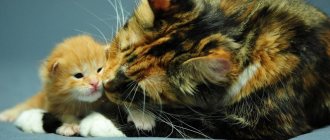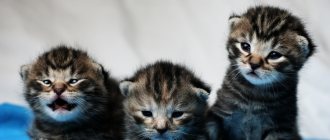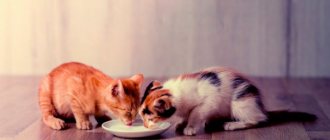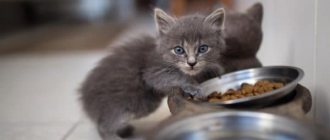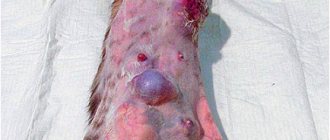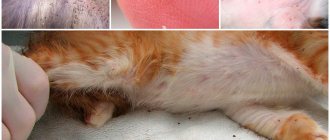How do little Bengals grow?
From a tiny lump grows a luxurious spotted short-haired animal with an affectionate domestic character. Sociable and intelligent cats quickly become attached to humans and require attention from the first day of their life. With proper care and nutrition, they grow quickly, turning into a luxurious animal. You can fall in love with this handsome spotted cat at first sight. Purebred Bengal cats respond to humans with love and devotion.
First month
A mini-leopard is born very tiny, weighing only 90-120 g. Sometimes very small kittens appear, viable individuals weigh more than 60 g. The weight largely depends on how many kittens are in the litter. They actively feed on colostrum and breast milk, build up immunity, and grow quickly. At 2 weeks the kitten will double its weight, and by the end of the fourth week it will weigh 400-700 g. If the pet is too thin, it will need additional attention.
After about ten days, hearing will appear, and after a few more days the kittens open their eyes. All these events will end by the end of the second week. Now the skeleton is strong enough, crawling and standing exercises begin. By the end of the third week, he can already sit and tries to walk carefully. A one-month-old Bengal's baby teeth appear and he begins to bite, scratch, and play. You can already determine the gender.
“When a newborn kitten is gaining too little weight, the diet of the nursing mother needs to be checked and adjusted.”
Second month
The kitten is strong enough to actively explore the world around him, plays a lot, runs around, but always returns to his mother - the source of food, warmth, and care. Particular entertainment is jumping from relatively high surfaces. It is necessary to limit access to potentially dangerous places, because the pet does not yet know how to correctly assess height. He is growing rapidly, at 2 months the weight reaches 1300-1500 g, mother's milk is no longer enough. It's time to introduce complementary foods and carry out deworming.
Third month
At 3 months, the kitten continues to develop; it has already completely switched to artificial nutrition. Time of first vaccinations. The color of the spotted coat, dark or white, naturally fades - this is phasing. The eyes are usually gray-blue, the color of the iris is formed. By the end of the month, the little Bengal already weighs about two kilograms.
He becomes even more active and restless. Security measures remain in effect. At this time, you need to communicate more with the kitten, educate it, because it is already ready to move to a new home. By this point, the pet should be accustomed to the tray.
“If the kitten is not gaining weight as rapidly after eight weeks as before, there is no need to worry. This is a normal change in growth dynamics for Bengals.”
Fourth month
The kitten becomes even more active, but remains not too careful. Security measures cannot be relaxed. The kitten is trained to use a scratching post. The color of the eyes changes, it has already formed, and phasing enters its final stage. If the move to a new house has taken place, the owner should constantly check the condition of the premises where the new family member lives.
Weight dynamics of Bengal kittens:
| Age | Approximate weight, g |
| In the first week | 70-120 |
| First month | 400-500 |
| 2-3 months | 500-2400 |
| 4-5 months | 2700-3600 |
| 5-6 months | 2900-3900 |
| 7 months | 4000 |
| 8-9 months | 4100-6000 |
| 10-12 months | 4200-6000 |
Narrow loopholes where the kitten can get stuck, wires, and other objects that can be chewed are unacceptable. Baby teeth are replaced by permanent teeth; for play, objects are needed that cannot be broken in order to partially swallow. Everything glassy, fragile, and breakable should be removed from the sphere of interests of a purebred pet. Puberty begins.
From five months to a year
From the time a kitten begins to change teeth, its immunity weakens somewhat. This continues for up to seven months. At about six months it is necessary to get a rabies vaccination if recommended by a veterinarian. After the cat appears in heat, you need to decide on her sterilization. This is a necessary measure for individuals not involved in breeding.
Males are castrated, if necessary, at seven or eight months, when they weigh four kilograms. It happens that a sexually mature kitten constantly yells, demanding a date with the cat. The problem needs to be resolved as early as possible to reduce stress for all residents of the house and for the Bengal itself.
By the end of seven months, the pet’s active growth is completed. He gains approximately 80% of his final weight, which will be gained at about two years of age and will be 6-8 kg. Female cats stop growing earlier than female cats, at about 5 months.
Information about the origin and appearance of representatives of the Bengal breed
The breed was born as a result of crossing small-sized Asian forest cats, called leopard cats because of the pattern on their fur, with such well-known, popular cat breeds as the Abyssinian, British Smoothhair, Mau, Egyptian and some others. This happened a little more than half a century ago thanks to the plan and hard work of the American plant breeder Jane Mill. So in the “Country of Origin” column the purebred Bengal has the USA. However, representatives of the purebred Bengal breed always have Asian blood.
General brief characteristics of the Bengal cat
The basic data for a general idea of the new elite type of domestic Bengal breed are as follows:
The official name is the domestic Bengal cat.
Subspecies – smooth or short-haired.
Country of origin: USA.
The breeding time is the last third of the 20th century.
Life expectancy is 12-17 years.
The weight of an adult Bengal is approximately 4 kg, a male is 6-7 kg.
Height (height at withers) - up to 40 cm, length with tail - up to 90 cm.
The colors recognized by the federations are brown, silver, blue.
Acceptable designs are stains, rosettes, and horizontal streaks.
About the name of the breed
The path to official recognition for Bengal cats was not easy. Only a third of a century after the birth of the first hybrids from a wild female Felis Bengalensis and a domestic Abyssinian cat in the early 1960s, representatives of the breed were registered as a new separate species of domestic feline. Initially, this breed was included in the documents of felinological associations under the name “safari”. Several more options were offered - for example, “Russian”. However, the species soon received a more logical name in connection with the obvious roots of its direct ancestors - in honor of wild Bengal cats. Bengal domestic cats are extremely similar to these representatives of the natural fauna; the epithet “mini-leopard” suits them perfectly. Not hybrids, but animals of the new domesticated cat breed include individuals from the F-4 (f4) generations, as well as their offspring.
About the basic external characteristics of Bengal cats and male cats
Bengal cats are a strong, sinewy, muscular breed. The sizes of representatives, as in wild fauna, range from medium (from 4 kilograms) to quite large (about 7 kg). The predator of the forest is distinguished by large, almost round eyes with an expressive outline, an almost straight profile with a wide nose, and convexly protruding anus on a relatively medium-sized head. Thick, dense, short and shiny coat is unusually soft and silky to the touch.
Official Bengal breed standards
According to the approved classifiers of such international cat federations as FCI, WCF, TICA, etc., the general appearance of purebred Bengals should be as follows:
- a body with a solid, by no means elegant, bone structure of average or slightly longer than average length - from about 90 centimeters with a tail, with the height of a large individual at the withers from 35 centimeters and above;
— the hind legs are powerful, noticeably longer than the front ones; paws are large, rounded, gathered into strong “fists”;
- the head looks like a modified wide wedge with rounded contours on a long, muscular neck, but proportional to the body.
The description of the representative of the Bengal breed is completed by a thick, straight tail with a rounded tip of medium length, hanging down.
Colors, tabby, hair quality of Bengal cats
You can read in detail about all the different coat colors of Bengals in special texts, but here is a list of those officially recognized in two categories of pattern - Spotted/roset and Marbled:
- brown with all shades and the desirable presence of rufism (rust, redness) - Brown Tabby (brown tabby); in the World Cat Federation (WCF) system it is the main one, its code is ben n24 (ben n24);
— silver with a distinct pattern makes up the division Black Silver Tabby, Silver Lynx Point/Marble, Silver Sepia Spotted/Marble, Silver Mink Spotted/Marble;
- blue, recently recognized only by some federations - Blue Bengals Tabby.
So far unrecognized are the magnificent panther-like black Bengals of the melanistic subspecies, several varieties of snow Bengal cats, as well as a recently bred subspecies with long, silky fur. When exhibiting at exhibitions or participating in other events, such representatives are officially listed as “Non Standard”.
As for the eye color of Bengals, they can be anything - bright and calm green, yellow, bright golden. Snow cats must be blue-eyed.
Special requirements of standards for the exterior of Bengal cats
The documents of felinological federations for representatives of the Bengal breed spell out clear requirements regarding color and type of patterns. Thus, the presence of Rufisms is unacceptable for silver Bengals. The patterns of spotted cats, including rosette cats, should not contain vertical “tiger” lines (horizontal stripes are allowed only on the tail and legs), and tabby marbled Bengals cannot have round spots.
No world federation recognizes any mestizos born from Bengal females. Moreover, there is an officially stated ban on crossing the Bengal breed with any other registered species of domestic cat. To improve the characteristics of the species, crossing with wild forest ancestors, widely found in southern Asian countries, the Far East, and the Philippines, is allowed.
Wool standards
The hair of Bengal cats is close-fitting, dense, and the hairs are short in length (usually longer in kittens). To the tactile perception, the fur coat is unusually soft, like a chinchilla’s, satiny-silky. Glitter gives a special chic to the exterior of Bengal cats - the amazing shine of hairs in the light. The effect that Jane Mill noticed in one of the wild kittens of Felis Bengalensis is given to the animal by a recessive gene - so glitter does not occur in all individuals. Modern breeders and experienced breeders are trying to consolidate this attractive feature when crossing.
How do Bengals develop?
| Days, months | Events, activities |
| 5-8 days | The ear canal opens |
| 7-12 days | Eyes open |
| 12-21 days | The first teeth appear |
| 13-16 days | Ability to navigate by sound |
| from 14 days | Vision becomes clearer |
| from 18 days | First claw trimming Ability to stand on paws |
| 21-30 days | Learn to walk ; Fang trimming and deworming if necessary |
| from 30 days | Start of complementary feeding, toilet training |
| 5-10 weeks | Routine prevention of helminths Immunity borrowed from the mother weakens |
| 6-16 week | Vaccination |
| 8-12 week | Revaccination |
| 3 months | Moving to a new home |
| 12-14 week | Permanent teeth appear, immunity decreases |
| 3.5-7 months. | Routine vaccination |
| 6 months | Puberty |
| 4-20 months | Sterilization, castration |
“Gaining excess weight is not common in Bengal kittens, but if it happens, you should contact your veterinarian.”
Care and maintenance
Bengals do not require any special care. The cat should be vaccinated regularly, given anti-parasitic tablets, monitor its diet, play and bathe as needed.
Hygiene
Important! To keep your pet healthy, you should pay attention to caring for the eyes, ears, claws and coat. To do this, remove dirt that has dried in the corners of your cat's eyes every day.
For the procedure, you can use wet baby wipes or a piece of cotton wool soaked in tea leaves or a special zoo lotion. The latter helps to cope with dark spots in the corners of the eyes of snowy and white Bengals.
Bengals do not require special care
Lotions for cats that relieve inflammation and remove ear mites are suitable for cleaning the ears. If the inside of the ear dries out, it is recommended to treat it with baby moisturizer. Brown or gray discharge is a reason to consult a veterinarian.
The Bengal does not need to specially trim or file its claws. The cat constantly wears down the claws on his front paws on a scratching post or rug, and chews on his hind paws.
The cat washes itself several times a day, combing out any loose hairs. This promotes the growth of new fur. Therefore, you should not bathe your pet unless absolutely necessary. But regular brushing improves skin regeneration, removes dirt and matted hairs, preventing the accumulation of hairballs in the animal’s stomach.
They bathe a Bengal cat if it gets dirty or to get rid of parasites. If the pet is sick, bathing is prohibited, as the procedure can provoke the progression of the disease.
The cat washes itself several times a day, combing out any loose hairs.
Diet and feeding
Bengals have a weak digestive system. Therefore, they need special nutrition. There are two types of food - natural or prepared (wet kibble or dry kibble).
Feeding your pet food from a human table is unacceptable. Spices, sweets, fatty and high-calorie foods are harmful to the cat.
Kittens up to 4 months of age are fed six times a day, from 4-6 months - four times, from 6 months to a year - 3 times. For adults, two meals a day is sufficient.
If there is any uneaten meat or prepared wet food left in the bowl, it should be thrown away. After eating a spoiled product, your pet may become poisoned. The exception is ready-made dry food. It can be left for a day.
Be sure to read:
Asher's cat: The largest and "wildest" domestic cat
Education and training
The Bengal cat is a bundle of energy; active games with the owner are important for him. A great option is hide and seek or chasing a rustling candy wrapper tied to a string.
Spending time together will increase mutual affection. Bengals are very sociable. They will be happy to “talk” to the owner.
When raising a kitten, it is worth teaching it the word “no”. To reinforce the prohibition, you can use a squirt gun or water gun.
Life expectancy and typical diseases
When raising a kitten, it is worth teaching it the word “no.”
The maximum age that Bengals live to is 13-16 years. Life expectancy depends on genetics, nutrition and maintenance. Cats of this breed are hardy and healthy.
But they may have genetic diseases - cardiac pathologies, which can cause death. Bengal cats are also susceptible to gastrointestinal infections, poisoning and feline leukemia.
Castration and sterilization
Sterilization and castration is a humane choice for an owner who does not plan to engage in breeding. During the operation, the male's spermatic ducts are tightened or the testicles are removed.
For females, medical, radiation and surgical sterilization is offered. The optimal solution is surgical removal of the animal's uterus and ovaries.
What could go wrong
Hypoglycemia, hypothermia, and dehydration are common causes of early death in newborn kittens. This syndrome develops in the first three weeks, when the ability to regulate temperature is still weak and the body's carbohydrate reserves are meager. Lethargy, apathy, sometimes against the background of convulsions, may indicate incipient hypoglycemia. The problem occurs as a result of insufficient feeding. There is not enough breast milk if:
- a nursing mother produces little milk;
- there is a delay in lactation;
- the number of offspring exceeds normal.
The condition is diagnosed by a doctor who injects the kitten with a glucose solution. It is important to pay attention to the symptoms in order to immediately provide assistance to the newborn. Bottle feeding with a milk replacer will help compensate for the lack of nutrients.
Before feeding, the kitten must take its temperature. If it is below 34 degrees, you cannot feed. Hypoglycemia is often accompanied by hypothermia. The newborn is not yet capable of thermoregulation. If the cat for some reason stops keeping him warm, hypothermia will occur.
At temperatures below 34 degrees, the digestion process is disrupted, the sucking reflex is reduced, and the kitten may simply choke on milk and die. You first need to gradually warm the kitten up, and then start feeding it. Several factors can help prevent hypothermia:
- regular temperature measurements in the nest;
- observing the behavior of a cat that should be with its offspring;
- control the humidity level in the nest.
Infrared lamps are used to warm kittens. They should not hang too low to avoid another problem - overheating. The normal humidity level is considered to be 60%. If the surrounding air is too dry and the newborn does not receive enough water (about 15 ml per 100 g of weight), dehydration will occur. Loose stools can provoke this situation.
A blind kitten's skin surface area is very large compared to its mass. In a warm, dry place, moisture evaporates quickly and dehydration occurs. It is necessary to regularly check whether the kittens are sucking milk and whether access to the nipples is restricted. Severe dehydration is treated with perfusion, intravenous or intraosseous, performed by a veterinarian. Subcutaneous injections at such an early age are ineffective and sometimes cause new diseases: abscesses, osmotic dehydration, etc.
These three conditions: underfeeding, hypothermia and dehydration are interconnected, since one of them can provoke the development of other dangerous processes. The kitten should be in a warm nest with relatives and have access to mother's milk. If your pet appears weak, you should:
- measure rectal temperature;
- warm him up if it is too low;
- give the warmed kitten a drink of sweetened water;
- feed him artificial milk;
- invite a veterinarian for an examination.
These simple measures and careful attention will help save the newborn’s life and get him out. The next problem that little Bengals face is bacteriological infections. They can affect the navel (omphalitis), eyes (ophthalmia), skin (septicemia). Preventing diseases is both simple and difficult. It is necessary to ensure hygiene procedures without disturbing newborns too much.
Umbilical infections can cause peritonitis. It is necessary to regularly monitor the condition of the navel. Diagnosis and antibacterial treatment are prescribed by a veterinarian. Eye infections are hidden and begin even before the eyes open. If, when you press on the eyelid, a drop of pus flows out from under it, you should immediately show your pet to a doctor.
To remove purulent deposits, it may be necessary to artificially open the eyelids. Next, the pet is treated with eye drops. If the condition is not detected early, the kitten will suffer from eye problems for the rest of its life or will lose its vision completely.
Skin infections thrive especially in damp environments. Therefore, the bathroom is not the best place for a cat's nest. Other causes of skin lesions in newborns may include:
- infection in the mother (infection occurs during childbirth);
- unsatisfactory hygienic condition of the nest;
- little or no colostrum.
If there is no hygiene, the nest stinks, this is unacceptable. Skin infections must be treated by a veterinarian, who will determine the type of bacteria and prescribe appropriate medications. In the absence of timely assistance, microbes or their products - toxins - enter the bloodstream, which leads to serious illness and death. Signs of neonatal infection may include:
- lethargy and apathy;
- eyes water;
- pinpoint hemorrhages on the skin;
- diarrhea;
- rectal prolapse;
- purulent discharge in the corners of the eyes;
- abscesses on the skin.
Any of these signs are reason to consult your veterinarian immediately. Some breeders give pregnant cats antibiotics as a preventive measure. This is a very bad practice because kittens develop disturbances in their intestinal bacterial flora and develop strains that are resistant to antibiotic treatment. Such drugs should be prescribed to a pregnant cat by a doctor if there are appropriate indications.
If your Bengal kitten is sneezing, he probably has a cold. But respiratory tract irritation may have other causes. Their presence or absence must be confirmed by a veterinarian. In parallel with antibacterial therapy, vitamins are prescribed.
It is worth noting that Bengals inherited excellent health from their wild ancestors. If kittens are provided with proper care, they grow healthy and strong.
What diseases do Bengal cats suffer from?
Representatives of this breed are strong and hardy animals. But they are also prone to certain diseases. Among them:
- Retinal atrophy (PRA-b) is an inherited disease that eventually leads to complete blindness.
- Hypertrophic cardiomyopathy (HCM) is a heart disease in which the walls of the ventricle thicken, leading to problems with the functioning of the circulatory system.
- Erythrocyte pyruvate kinase deficiency (PK deficiency) is a condition that leads to hemolytic anemia associated with impaired functioning of red blood cells.
- Flat chest syndrome (FCK) is a disease that appears in kittens in the first months of life and can be fatal.
- Dry nose syndrome. It appears in young animals under one year of age, first in the form of crusts and cracks; if neglected, ulcers may appear.
Also, Bengals, like any other cats, can suffer from food and contact allergies, problems with the digestive and genitourinary system, skin diseases and more.
Even a healthy animal needs to be constantly and carefully monitored. If there are any changes in his behavior or suspicious symptoms, it is better to immediately contact a veterinary clinic. This will help you take action in time and avoid bad consequences.
How to choose a pet
Where can I get a beautiful Bengal kitten? First you need to find a good nursery. The Bengal cat breed is rare and exotic, so prices for Bengal kittens are never low. You should not buy an animal with dubious pedigree and heredity for several thousand dollars. Bengal club pets have a verified biography, receive the necessary care and good upbringing. A responsible breeder provides documents for the kitten and draws up an official sales contract. This is a safe buy.
“Bengals are active and sociable kids, they are suitable for those who are ready to devote enough time to their pet.”
Prices for purebred Bengal cats start at $5,000. Are leopard kittens cheap or expensive? Depends on the class. Bengal kitten F1, girl or boy, pet, elite show class individuals intended for breeding and/or participation in exhibitions, will cost several times more. You will have to spend a lot on the items and materials needed to keep a young Bengal tiger: a tray, a house, bowls, food, medicine, litter, toys, etc.
Proper care from a good breeder from the first days of life ensures the health of the kitten. Elite kittens practically do not get sick if they are provided with appropriate conditions. Breeders lay the foundation for normal socialization and education of the Bengal. The first days in your new home will go smoothly. The new owner just has to develop useful skills.
After the cattery has been selected, they begin to select kittens on the website. If the choice is made, you can order or reserve a kitten. Many future owners come to meet a new family member, but you can only take home a pet that is three months old.
A good breeder will not give away a kitten earlier, since it is necessary to complete its upbringing, carry out the necessary vaccinations and deworming. When examining, you can pay attention to the eyes and ears. In well-groomed individuals they are clean. Information about the pedigree and characteristics of birth will help to get an idea of the possible development of events during the kitten's growth.
For example, two not too large individuals rarely produce large offspring. If there were many kittens in the litter, a slight lag in the rate of weight gain is understandable. Such pets need more attention and nutrients to compensate for underweight.
“Dim and fuzzy fur color in a three-month-old Bengal, as well as a cloudy yellow-green iris, are normal. During phasing, the kitten should look like this. The final formation of eye color and coat will occur later.”
How to care for Bengal cats
The silky and short coat of Bengals needs to be brushed once a week or two using a special brush. If you accustom your pet to this procedure from childhood, it will not cause any special problems.
Caring for the beautiful coat of a Bengal will not cause problems. Photo: Evgenia Stadnikova / Shutterstock
Bengal cats are very clean, so they do not need frequent bathing. Water treatments may be necessary if the pet is very dirty. At the same time, washing Bengals will not cause any special problems. Cats of this breed are calm and even interested in water, play with the streams with pleasure, and some are not even averse to having fun in the bath.
You also need to pay attention to the animal’s claws, even if the cat regularly uses a scratching post. You can trim them at home, but if difficulties arise with the procedure, it is better to contact a veterinary clinic. As for ear hygiene, it is advisable to inspect them at least a couple of times a week and clean them as they become dirty using special lotions or other products.
Why you can’t pick up a kitten early
The desire to take a new pet home as soon as possible is understandable, but pursuing it is dangerous. Yes, there are irresponsible sellers who are ready to give an eight-month-old kitten to a new owner, but a responsible breeder will never allow him to be taken away from his mother and brothers and sisters so early.
From six to twelve weeks of age, the kitten continues to develop mentally, emotionally, physiologically and psychologically. For normal development, he needs to stay with his mother and other kittens. Early weaning will cause stress, which can significantly worsen your pet's condition.
The kitten’s immunity at this stage is very vulnerable, since the innate “margin of safety” has already been depleted, and the ability to resist diseases after the first vaccination is still developing. In a nursery, the likelihood of encountering new diseases is minimal, but it increases when moving to a new home.
Colds and bowel problems are especially dangerous at this time. Vaccination and the formation of new immunity under familiar conditions protect well against possible diseases. The kitten is not yet physically strong; the stress of moving often turns out to be an excessive burden on a weak body.
The transition from breastfeeding to solid food occurs gradually. At eight weeks, the kitten is still at the beginning of this journey. By the twelfth week he is completely ready to eat ready-made food. It is the mother cat who teaches the kitten to cope with the disappointment of lack of milk. She is nearby, ready to caress him. The stress on the psyche is reduced, and the risk of behavioral problems in the future is minimal. The breeder accustoms the kitten to being held.
Digestion will be much better if the new owner follows the breeder's recommendations for feeding the pet. Switching to a new type of diet can cause diarrhea. Diarrhea causes dehydration and poses a danger to your pet. Breeders always know how to take care of a kitten in such a situation, but new owners almost never do. The ability to use a litter tray develops around 10-12 weeks. A two month old kitten is too young to learn this skill.
“Keeping a purebred kitten for an extra month is not cheap. If the seller willingly gives away a pet at two months, he is more interested in profit than in the successful development of the little Bengal. It’s better to refuse a dubious deal and turn to a breeder with a good reputation.”
A kitten without documents, but with a similar color, may cost less than that of a breeder, but it may not even be a Bengal, but a hybrid from a random mating. His health, upbringing and ability to learn are in big question. A well-mannered Bengal cat is not aggressive. He can be trained to use a regular toilet; he understands that a person’s arms and legs are not a toy.
Do not be afraid that at three months a kitten is less affectionate than at eight weeks. On the contrary, the stress of early relocation and separation from mother, illnesses that are almost certain to occur, can make adaptation difficult. A healthy and developed pet has the strength and opportunity to calmly explore a new place and fall in love with its new family.
If there are other animals in the house, socializing the cat before 12-14 weeks is even more important. During this period, the kitten acquires communication skills with other kittens and adults. The ability to calmly communicate with people and not be afraid of them is also formed at this time. The correct timing for moving eliminates problems for both the owner and the little Bengal.
The new owner can learn a lot of useful information from the breeder: what to feed, how to properly care for them, trim their nails and wean them off bad habits if they appear, how to distinguish the first signs of illness, calm them down, clean their ears, when to vaccinate, etc. It should be remembered that runners always live in an apartment and need space to play. A kitten worth several tens of thousands of rubles should not walk on its own. A curious and active pet can run away in just a minute.
